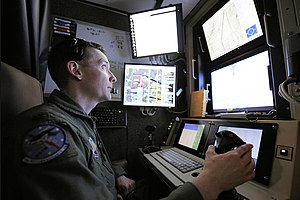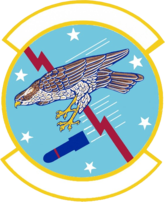|
6th Attack Squadron
The 6th Attack Squadron is an active United States Air Force unit, assigned to the 49th Wing at Holloman Air Force Base, New Mexico. The squadron is a formal training unit for crews learning to operate unmanned aerial vehicles. The squadron was first organized in 1943 as the 794th Bombardment Squadron, one of the first Boeing B-29 Superfortress units of the Army Air Forces. After training in the United States, the squadron moved to India, where it participated in the strategic bombing campaign against Japan. In 1945, it moved to the Mariana Islands, from which it continued its attacks against Japan, earning three Distinguished Unit Citations before returning to the United States. It converted to the aerial reconnaissance role as the 6th Reconnaissance Squadron, becoming one of the first units in Strategic Air Command (SAC) before inactivating in March 1946. The squadron was again activated in SAC in June 1955 as the 6th Strategic Reconnaissance Squadron, flying Boeing RB-47 Stratojets, before returning to the bombardment mission as the 6th Bombardment Squadron. It was inactivated in 1962 as the B-47 was phased out, but activated as a Boeing B-52 Stratofortress unit the following year. It was inactivated in December 1969, when SAC removed older B-52s from its inventory. The squadron was activated in its current role in 2009. HistoryWorld War IIOrganization and training in the United StatesThe squadron was first organized at Smoky Hill Army Air Field, Kansas on 1 August 1943 as the 794th Bombardment Squadron, one of the four original squadrons of the 468th Bombardment Group. It was intended to be a Boeing B-29 Superfortress squadron, however due to the lack of B-29 availability, it was initially equipped with Boeing B-17 Flying Fortresses.[1][2] Smoky Hill was one of four bases chosen for B-29 training based on their proximity to Boeing's factory at Wichita, Kansas, where most of the early Superfortresses would be produced.[3] Delays in producing the B-29, labor disputes at the engine manufacturer, and modifications to the planes to make them ready for combat resulted in belated deliveries to combat units and it was close to the end of 1943 before aircrews could train in the new bomber in any number. Ground echelon personnel began shipping out to prepare the airfields for the bombers without completing their training in the United States.[4] The air echelon of the squadron trained with the B-29 in Kansas until March 1944, when it departed for its first overseas base, Kharagpur Airfield, Bengal, India,[1] to participate in Operation Matterhorn, which called for B-29 attacks from advanced bases in China, while the bombers' main bases were in India.[5] The squadron completed its training and deployed from the United States to India in March 1944, flying across the South Atlantic and Africa to reach its combat station.[1][2] Combat in the China Burma India Theater The squadron arrived at Kharagpur in mid-April. Once all elements of the 468th Group had arrived at Kharagpur in June, the squadron became part of Twentieth Air Force, which reported directly to Headquarters, Army Air Forces, bypassing theater command. Its initial missions were transporting supplies and equipment to staging airfields in China, and it did not fly its first combat mission until 5 June, when it participated in a raid on railroad repair facilities near Bangkok, Thailand. Ten days later, it participated in the first attack on the Japanese Home Islands since the Doolittle Raid two years earlier.[2] Attacks on Japan required staging through forward bases in China, and squadron bombers consumed twelve gallons of fuel to transport one gallon that could be used for combat missions.[6] The squadron moved its available aircraft to its forward base at Pengshan Airfield near Chengtu. Staging of B-29s, already armed and loaded with bombs began on 13 June and was only completed on the day of the raid, with only refueling needed in China. The primary target for this mission was the Imperial Steel Works at Yawata.[7] The unit staged through bases not only in China for attacks on Japan, but from other bases in India and Ceylon. It conducted mining operations off the coasts of French Indochina, near Saigon and China, near Shanghai. It attacked Japanese targets in Southeast Asia, including aircraft factories, naval installations, transportation facilities and iron works, and it flew sorties to targets as distant as Indonesia. In August 1944, the squadron again struck the Imperial Steel Works in Yawata, earning its first Distinguished Unit Citation.[1][2] Fighter opposition on this attack included the first experience of a Japanese fighter plane intentionally ramming a B-29.[8] In October 1944, the 468th Bombardment Group was reorganized, along with other groups in XX Bomber Command. The squadron's strength was increased by three B-29s made available by the inactivation of the 795th Bombardment Squadron and maintenance personnel from the disbanding maintenance squadrons of the 468th.[9] During its remaining time in the China-Burma-India Theater, the squadron found itself more frequently attacking tactical targets in Formosa and the Philippines to support of forces advancing in the Pacific.[10] The squadron abandoned its forward bases in China in January 1945, but continued attacks from Indian airfields. It attacked a supply dump in Rangoon, Burma; rail targets near Bangkok, Thailand and Kuala Lampur, Malaya, and the drydock in Singapore. On 4 May, the squadron left its base in India for the island of Tinian, although elements of the 468th Group had begun moving as early as February.[1][2] Combat in the PacificThe squadron arrived at its new base at West Field (Tinian) in the Mariana Islands on 7 May 1945. The squadron was able to operate from its new base against Japan without the need to use forward bases. Most of its attacks were nighttime raids with incendiary bombs. Its attacks in late May with incendiaries against Tokyo and Yokohama earned the squadron its second DUC. It participated against some strategic targets from high altitude, and earned a third DUC for a daylight attack on an aircraft manufacturing plant at Takarazuka. The squadron also continued minelaying missions.[2] Following V-J Day, squadron Superfortesses dropped food and supplies to Allied prisoners of war. It also participated in show of force missions.[2] Strategic Air CommandInitial assignmentThe squadron departed Tinian in November 1945 and reassembled at Fort Worth Army Air Field, Texas in December, where it was redesignated the 6th Reconnaissance Squadron and began converting to the aerial reconnaissance mission. With the beginning of the new year, the squadron moved to Roswell Army Air Field, New Mexico, where it trained again with the Superfortress. When Strategic Air Command (SAC) was formed in March, the squadron became one of SAC's first reconnaissance units as part of the 311th Reconnaissance Wing. However it did not remain long with SAC, but was inactivated at the end of the month.[1][2] B-47 Stratojet operationsThe squadron was activated along with the 70th Strategic Reconnaissance Wing in June 1955 and equipped with the Boeing RB-47 Stratojet. Although it was nominally stationed at Little Rock Air Force Base, Arkansas, the squadron operated from Lockbourne Air Force Base, Ohio while construction was completed to prepare Little Rock's runways for the jet powered B-47. Once the squadron moved to Little Rock in October 1955, it conducted global reconnaissance and provided targeting materials to headquarters, SAC. In February 1958, the 70th Wing began reducing its reconnaissance operations and in September 1958 squadron began to train B-47 and RB-47 aircrews, with the last RB-47 class graduating in October 1961. The 70th Wing began transitioning to the medium bomber mission in late 1961, but it had not become combat ready in June 1962, when B-47s at Little Rock were consolidated into the 384th Bombardment Wing and the squadron was inactivated.[1][11] B-52 Stratofortress operationsIn the late 1950s SAC was concerned that bases with large concentrations of bombers made attractive targets for a Soviet attack. SAC's response was to break up its wings and scatter their aircraft over a larger number of bases.[12] As part of this force dispersal, SAC established the 4123d Strategic Wing at Clinton-Sherman Air Force Base, Oklahoma. However, the 4123d was a Major Command controlled (MAJCON) wing, which could not carry a permanent history or lineage,[13] and SAC wanted to replace it with a permanent unit. In February 1963, the 70th Bombardment Wing replaced the 4123d, and the 6th was reactivated, assuming the personnel and Boeing B-52E Stratofortresses of the 4123d's 98th Bombardment Squadron, which was simultaneously inactivated.[1][11][14] The squadron trained for strategic bombing missions.[11] One half of the squadron's aircraft were maintained on fifteen minute alert, fully fueled and ready for combat to reduce vulnerability to a Soviet missile strike, except for periods in which the aircraft were deployed.[15] Some personnel were deployed to the Pacific after 1968, and for several months in 1968 and in 1969, all of the squadron's aircraft and most of its personnel were deployed to Southeast Asia, where they were attached to other SAC organizations conducting combat missions under Operation Arc Light.[11] "A few months after the first B-52Bs started leaving the operational inventory, Robert S. McNamara, Secretary of Defense . . . announced another phaseout program that would further reduce SAC’s bomber force. Basically, this program called for the mid-1971 retirement of all of the B-52Cs, and of several subsequent B-52 models."[16] With the implementation of this program, the squadron was inactivated at the end of 1969.[1] Unmanned aerial vehicle trainingThe squadron became the 6th Reconnaissance Squadron and was activated at Holloman Air Force Base, New Mexico in October 2009. The squadron provided initial qualification training for pilots and sensor operators learning to operate the General Atomics MQ-1 Predator remotely operated aircraft until 2017, when the General Atomics MQ-9 Reaper replaced the MQ-1. In 2016, the squadron became the 6th Attack Squadron to more accurately reflect the roles of the unmanned aerial vehicles it trained with.[1][17] Lineage
Assignments
Stations
Aircraft
Awards and campaigns
See also
ReferencesNotes
Bibliography
External links |
||||||||||||||||||||||||||||||||||||||||||||||||||||||||||||||||||||||||||||||||






